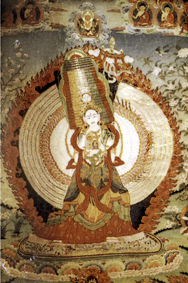Sitatapatra: Difference between revisions
Stefan Mang (talk | contribs) No edit summary |
Stefan Mang (talk | contribs) No edit summary |
||
| Line 1: | Line 1: | ||
[[Image:204_Dukkarweb.jpg|frame|Dukkar]] | [[Image:204_Dukkarweb.jpg|frame|Dukkar]] | ||
'''Sitatapatra''' (Skt. ''Sitātapatrā''; Tib. གདུགས་དཀར་, [[Wyl.]] ''gdugs dkar''; Tib. ''Dukkar'') is a female deity whose [[dharani]] issued forth from the crown protuberance of [[Buddha Shakyamuni]]. According to [[Khedrup Jé]] the Sitatapatra texts are classified as [[Kriya Tantra]] and belong to the [[Buddha family]]. The Lord of the family is the Buddha [[Vairocana]]. Sitatapatra gained great popularity as a powerful method to avert obstacles already in ancient India and has been continuously practiced up to the present day. Sitatapatra is invoked to protect the practitioners against calamities and malignant beings. Reciting her mantra is said to avert evil influences and purify defilements. She is often depicted with 1,000 heads, 1,000 arms and 1,000 legs, her central hands holding a dharma wheel and the handle of the white parasol from which she takes her name. The Sitatapatra dharanis were often also inserted as [[Dharmakaya]] relics into [[Stupa]]s. | '''Sitatapatra''' (Skt. ''Sitātapatrā''; Tib. གདུགས་དཀར་, [[Wyl.]] ''gdugs dkar''; Tib. ''Dukkar'') is a female deity whose [[dharani]] issued forth from the crown protuberance of [[Buddha Shakyamuni]], while he was remaining in [[samadhi]] in the assembly hall of the gods in [[the heaven of the thirty-three]]. According to [[Khedrup Jé]] the Sitatapatra texts are classified as [[Kriya Tantra]] and belong to the [[Buddha family]]. The Lord of the family is the Buddha [[Vairocana]]. Sitatapatra gained great popularity as a powerful method to avert obstacles already in ancient India and has been continuously practiced up to the present day. Sitatapatra is invoked to protect the practitioners against calamities and malignant beings. Reciting her mantra is said to avert evil influences and purify defilements. She is often depicted with 1,000 heads, 1,000 arms and 1,000 legs, her central hands holding a dharma wheel and the handle of the white parasol from which she takes her name. The Sitatapatra dharanis were often also inserted as [[Dharmakaya]] relics into [[Stupa]]s. | ||
==Texts== | ==Texts== | ||
Revision as of 13:53, 18 October 2016

Sitatapatra (Skt. Sitātapatrā; Tib. གདུགས་དཀར་, Wyl. gdugs dkar; Tib. Dukkar) is a female deity whose dharani issued forth from the crown protuberance of Buddha Shakyamuni, while he was remaining in samadhi in the assembly hall of the gods in the heaven of the thirty-three. According to Khedrup Jé the Sitatapatra texts are classified as Kriya Tantra and belong to the Buddha family. The Lord of the family is the Buddha Vairocana. Sitatapatra gained great popularity as a powerful method to avert obstacles already in ancient India and has been continuously practiced up to the present day. Sitatapatra is invoked to protect the practitioners against calamities and malignant beings. Reciting her mantra is said to avert evil influences and purify defilements. She is often depicted with 1,000 heads, 1,000 arms and 1,000 legs, her central hands holding a dharma wheel and the handle of the white parasol from which she takes her name. The Sitatapatra dharanis were often also inserted as Dharmakaya relics into Stupas.
Texts
There are innumerable practices of Sitapatra in the many Buddhist traditions in the world. The following are the four canonical texts found in the Dharani section of the Dergé Kangyur, all of which are translation from Sanskrit originals.
- The Spell of Uṣṇīṣasitātapatrā (Skt.uṣṇīṣa sitātapatrā aparājita pratyaṅgirā mahā vidyārājñī, Tib. གཙུག་ཏོར་གདུགས་དཀར་གྱི་རིག་སྔགས།, Wyl. gtsug tor gdugs dkar gyi rig sngags., or more fully Skt. ārya sarva tathāgatoṣṇīṣa sitātapatrā nāma aparājita pratyaṅgirā mahā vidyārājñī, Wyl. ('phags pa de bzhin gshegs pa thams cad kyi gtsug tor nas byung ba gdugs dkar po can zhes bya ba gzhan gyis mi thub ma phyir zlog pa'i rig sngags kyi rgyal mo chen mo, D 590/985)
- The Incantation of the Supremely Accomplished Sitātapatrā (Tib. གདུགས་དཀར་མཆོག་གྲུབ་ཀྱི་གཟུངས།, Wyl. gdugs dkar mchog grub kyi gzungs, or more fully Skt. ārya tathāgatoṣṇīṣa sitātapatrā parājita mahā pratyaṅgirā parama siddha nāma dhāraṇī, Wyl. 'phags pa de bzhin gshegs pa'i gtsug tor nas byung ba'i gdugs dkar po can gzhan gyis mi thub pa phyir zlog pa chen mo mchog tu grub pa zhes bya ba'i gzungs, D 591.
- The Incantation of Sitātapatrā (Skt. uṣṇīṣa sitātapatrā aparājitā dhāraṇī, Tib. གདུགས་དཀར་གྱི་གཟུངས།, Wyl. gdugs dkar gyi gzungs, or more fully Skt. ārya tathāgatoṣṇīṣa sitātapatre aparājitā nāma dhāraṇī, Wyl. 'phags pa de bzhin gshegs pa'i gtsug tor nas byung ba'i gdugs dkar po can gzhan gyis mi thub pa zhes bya ba'i gzungs, D 592/986)
- The Incantation of Sitātapatrā (Skt. uṣṇīṣa sitātapatrā aparājitā dhāraṇī, Tib. གདུགས་དཀར་གཟུངས།, Wyl. gdugs dkar gzungs, or more fully Skt. ārya tathāgatoṣṇīṣa sitātapatrā nāma aparājitā dhāraṇī, Wyl. 'phags pa de bzhin gshegs pa'i gtsug tor nas byung ba'i gdugs dkar po can gzhan gyis mi thub pa zhes bya ba'i gzungs, D 593)
References
- Porció, Tibor. The One with the White Parasol: Four Sitātapatrā Texts in the Derge Kanjur and a Dunhuang Text (Pelliot tibétain No. 45) with an Annotated English Translation of the Longest Canonical Version. Ph.D. Thesis. University of Vienna, 2000.
- Porció, Tibor. “On the Brāhmī Glosses of the Uygur Sitātapatrā Text.” In Central Asiatic Journal Vol. 47, No. 1, 2003: 91 - 109.